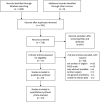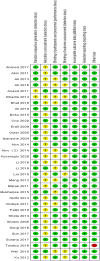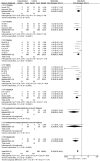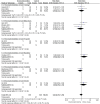Effects of Dexmedetomidine on Emergence Agitation and Recovery Quality Among Children Undergoing Surgery Under General Anesthesia: A Meta-Analysis of Randomized Controlled Trials
- PMID: 33304867
- PMCID: PMC7694572
- DOI: 10.3389/fped.2020.580226
Effects of Dexmedetomidine on Emergence Agitation and Recovery Quality Among Children Undergoing Surgery Under General Anesthesia: A Meta-Analysis of Randomized Controlled Trials
Abstract
Background: Emergence agitation (EA) is one of the most common and intractable postoperative complications among children undergoing surgery under general anesthesia. Dexmedetomidine, an α(2)-adrenoceptor agonist, offers an ideal sedation, reduces preoperative anxiety, and facilitates smooth induction of anesthesia, and it is widely used in pediatric surgery. We aimed to evaluate the efficacy of dexmedetomidine for preventing emergence agitation in children after general anesthesia. Methods: We comprehensively reviewed PubMed, Cochrane Library, EMBASE, and Web of Science databases to search all randomized controlled trials, published before April 22, 2020, investigating the efficacy of dexmedetomidine in preventing the emergence agitation in children after general anesthesia. The meta-analysis was performed using Review Manager 5.3. The primary outcome was the incidence of emergence agitation. Secondary outcomes included the number of patients requiring rescue analgesic, number of patients with postoperative nausea and vomiting, emergence time, extubation time, and time to discharge from the post-anesthesia care unit. Results: We included a total of 33 studies, comprising 2,549 patients in this meta-analysis. Compared with saline, dexmedetomidine significantly reduced the emergence agitation incidence [risk ratio (RR) 0.29; 95% confidence interval (CI) 0.22-0.37; p < 0.00001], incidence of postoperative nausea and vomiting (RR 0.46; 95% CI 0.3-0.69; p = 0.0002), and the requirement of rescue analgesic (RR 0.29; 95% CI 0.18-0.44; p < 0.00001). Furthermore, children in the dexmedetomidine group experienced a longer emergence time [mean difference (MD) 2.18; 95% CI 0.81-3.56; p = 0.002] and extubation time (MD 0.77; 95% CI 0.22-1.31; p = 0.006) compared with those in the saline group. However, no significant difference was observed in the time to discharge from the post-anesthesia care unit (MD 2.22; 95% CI -2.29-6.74; p = 0.33) between the two groups. No significant differences were observed between the effects of dexmedetomidine and other drugs like midazolam, propofol, fentanyl, tramadol, and clonidine in terms of the emergence agitation incidence and other parameters, except for the requirement of rescue analgesic (RR 0.45; 95% CI 0.33-0.61; p < 0.00001). Conclusions: Dexmedetomidine can prevent emergence agitation, relieves postoperative pain, decreases the requirement of rescue analgesic, and decreases the postoperative nausea and vomiting events.
Keywords: children; dexmedetomidine; emergence agitation; general anesthesia; meta-analysis.
Copyright © 2020 Yang, Hu, Peng, Chen, Zhou, Yang, Yang and Wang.
Figures









Similar articles
-
Meta-analysis of dexmedetomidine on emergence agitation and recovery profiles in children after sevoflurane anesthesia: different administration and different dosage.PLoS One. 2015 Apr 13;10(4):e0123728. doi: 10.1371/journal.pone.0123728. eCollection 2015. PLoS One. 2015. PMID: 25874562 Free PMC article.
-
The Effect of Dexmedetomidine on Postanesthesia Care Unit Discharge and Recovery: A Systematic Review and Meta-Analysis.Anesth Analg. 2022 Jun 1;134(6):1229-1244. doi: 10.1213/ANE.0000000000005843. Epub 2022 Jan 27. Anesth Analg. 2022. PMID: 35085107
-
Dexmedetomidine vs midazolam as preanesthetic medication in children: a meta-analysis of randomized controlled trials.Paediatr Anaesth. 2015 May;25(5):468-76. doi: 10.1111/pan.12587. Epub 2015 Jan 6. Paediatr Anaesth. 2015. PMID: 25559766
-
The effect of intranasal dexmedetomidine administration on emergence agitation or delirium in pediatric patients after general anesthesia: A meta-analysis of randomized controlled trials.Paediatr Anaesth. 2023 Aug;33(8):636-646. doi: 10.1111/pan.14689. Epub 2023 May 1. Paediatr Anaesth. 2023. PMID: 37128675
-
Remimazolam vs. propofol for induction and maintenance of general anesthesia: A systematic review and meta-analysis of emergence agitation risk in surgical populations.J Clin Anesth. 2025 Apr;103:111815. doi: 10.1016/j.jclinane.2025.111815. Epub 2025 Mar 22. J Clin Anesth. 2025. PMID: 40120546
Cited by
-
Low-dose esketamine for the prevention of emergency agitation in children after tonsillectomy: A randomized controlled study.Front Pharmacol. 2022 Dec 20;13:991581. doi: 10.3389/fphar.2022.991581. eCollection 2022. Front Pharmacol. 2022. PMID: 36605396 Free PMC article.
-
Risk factors for emergence agitation during the awakening period in elderly patients after total joint arthroplasty: a retrospective cohort study.BMJ Open. 2023 May 10;13(5):e068284. doi: 10.1136/bmjopen-2022-068284. BMJ Open. 2023. PMID: 37164475 Free PMC article.
-
Influencing factors and risk prediction model for emergence agitation after general anesthesia for primary liver cancer.World J Gastrointest Surg. 2024 Jul 27;16(7):2194-2201. doi: 10.4240/wjgs.v16.i7.2194. World J Gastrointest Surg. 2024. PMID: 39087110 Free PMC article.
-
The Sedative Effects of Inhaled Nebulized Dexmedetomidine on Children: A Systematic Review and Meta-Analysis.Front Pediatr. 2022 May 20;10:865107. doi: 10.3389/fped.2022.865107. eCollection 2022. Front Pediatr. 2022. PMID: 35669400 Free PMC article.
-
The Effects of Different Doses of Alfentanil and Dexmedetomidine on Prevention of Emergence Agitation in Pediatric Tonsillectomy and Adenoidectomy Surgery.Front Pharmacol. 2022 Feb 2;13:648802. doi: 10.3389/fphar.2022.648802. eCollection 2022. Front Pharmacol. 2022. PMID: 35185554 Free PMC article.
References
Publication types
LinkOut - more resources
Full Text Sources
Miscellaneous

